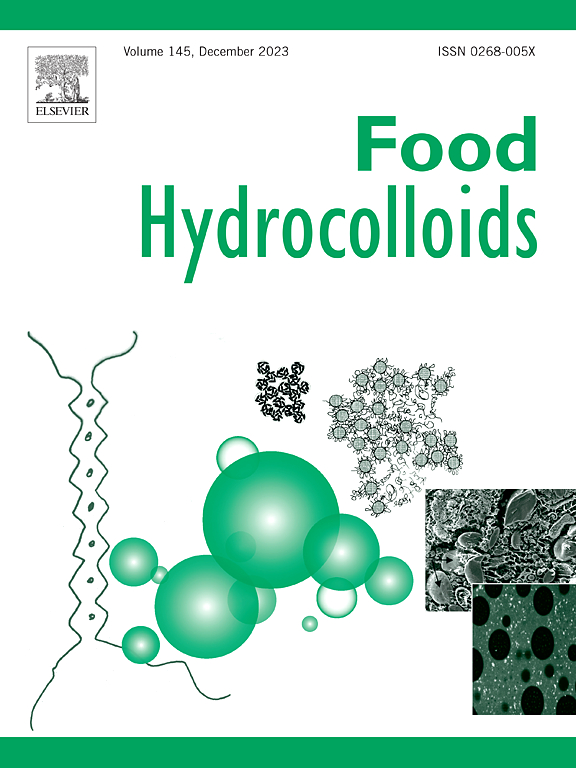Microencapsulation of Acer truncatum seed oil using chickpea protein isolate–low/high-methoxy citrus pectin complex coacervates: Preparation, stability analysis, and application in milk
IF 11
1区 农林科学
Q1 CHEMISTRY, APPLIED
引用次数: 0
Abstract
Acer truncatum seed oil (ATSO) is a promising novel food resource. However, ATSO's low solubility in water, poor stability, and low oral bioavailability limit its application in the food industry. Herein, ATSO was microencapsulated using complex coacervates formed by food-derived bio-macromolecular chickpea protein isolate (CPI), low-methoxy citrus pectin (LMCP), and high-methoxy citrus pectin (HMCP). The CPI-LMCP and CPI-HMCP complex coacervates were prepared and characterized. The selected protein-to-pectin ratio was 6:1 at pH 4.1. Characterization by Fourier transform infrared spectroscopy and scanning electron microscopy confirmed that the formation of CPI-LMCP and CPI-HMCP complex coacervates was driven by electrostatic interactions and exhibited a gel network structure. The successful encapsulation of ATSO in CPI-LMCP or CPI-HMCP complex coacervates was confirmed using inverted fluorescence microscopy characterization. The encapsulation efficiency of CPI-HMCP-ATSO microcapsules (80.22 % ± 2.16 %) was higher than that of CPI-LMCP-ATSO microcapsules (76.25 % ± 3.46 %). In addition, both microcapsules maintained their structural integrity in simulated food matrices with high salt and sucrose levels. The encapsulated ATSO exhibited higher thermal and oxidative stability than free oil. In vitro, gastrointestinal digestion studies revealed that CPI-HMCP-ATSO microcapsules significantly stabilized ATSO in simulated gastric fluid and achieved controlled release in simulated intestinal fluid. Additionally, ATSO microcapsules were incorporated into milk for the first time. Milk supplemented with ATSO microcapsules had a better sensory profile compared to the control formulation. Overall, the successful preparation of ATSO microcapsules promoted the generation of well-characterized nervonic acid–rich dairy products.

鹰嘴豆分离蛋白-低/高甲氧基柑橘果胶复合物凝聚物微胶囊化槭籽油:制备、稳定性分析及在牛奶中的应用
槭仁油是一种很有前途的新型食物资源。然而,ATSO在水中溶解度低,稳定性差,口服生物利用度低,限制了其在食品工业中的应用。本研究采用由食物来源的生物大分子鹰嘴豆分离蛋白(CPI)、低甲氧基柑橘果胶(LMCP)和高甲氧基柑橘果胶(HMCP)形成的复合凝聚体对ATSO进行微胶囊化。制备了CPI-LMCP和CPI-HMCP配合物凝聚体并对其进行了表征。选择的蛋白与果胶的比例为6:1,pH为4.1。傅里叶变换红外光谱和扫描电镜表征证实CPI-LMCP和CPI-HMCP复合物凝聚物的形成是由静电相互作用驱动的,并呈现凝胶网络结构。通过倒置荧光显微镜表征,证实ATSO在CPI-LMCP或CPI-HMCP复合物凝聚体中的成功包封。CPI-HMCP-ATSO微胶囊的包封率(80.22%±2.16%)高于CPI-LMCP-ATSO微胶囊的包封率(76.25%±3.46%)。此外,两种微胶囊在高盐和高蔗糖水平的模拟食物基质中保持结构完整性。与游离油相比,包封后的ATSO具有更高的热稳定性和氧化稳定性。体外胃肠消化研究表明,CPI-HMCP-ATSO微胶囊在模拟胃液中显著稳定ATSO,在模拟肠液中实现控释。此外,还首次将ATSO微胶囊掺入牛奶中。与对照配方相比,添加了ATSO微胶囊的牛奶具有更好的感官特征。综上所述,ATSO微胶囊的成功制备促进了表征良好的富神经酸乳制品的产生。
本文章由计算机程序翻译,如有差异,请以英文原文为准。
求助全文
约1分钟内获得全文
求助全文
来源期刊

Food Hydrocolloids
工程技术-食品科技
CiteScore
19.90
自引率
14.00%
发文量
871
审稿时长
37 days
期刊介绍:
Food Hydrocolloids publishes original and innovative research focused on the characterization, functional properties, and applications of hydrocolloid materials used in food products. These hydrocolloids, defined as polysaccharides and proteins of commercial importance, are added to control aspects such as texture, stability, rheology, and sensory properties. The research's primary emphasis should be on the hydrocolloids themselves, with thorough descriptions of their source, nature, and physicochemical characteristics. Manuscripts are expected to clearly outline specific aims and objectives, include a fundamental discussion of research findings at the molecular level, and address the significance of the results. Studies on hydrocolloids in complex formulations should concentrate on their overall properties and mechanisms of action, while simple formulation development studies may not be considered for publication.
The main areas of interest are:
-Chemical and physicochemical characterisation
Thermal properties including glass transitions and conformational changes-
Rheological properties including viscosity, viscoelastic properties and gelation behaviour-
The influence on organoleptic properties-
Interfacial properties including stabilisation of dispersions, emulsions and foams-
Film forming properties with application to edible films and active packaging-
Encapsulation and controlled release of active compounds-
The influence on health including their role as dietary fibre-
Manipulation of hydrocolloid structure and functionality through chemical, biochemical and physical processes-
New hydrocolloids and hydrocolloid sources of commercial potential.
The Journal also publishes Review articles that provide an overview of the latest developments in topics of specific interest to researchers in this field of activity.
 求助内容:
求助内容: 应助结果提醒方式:
应助结果提醒方式:


